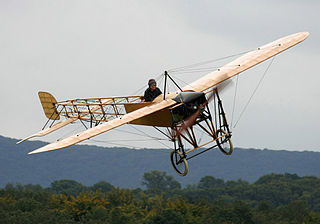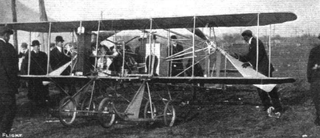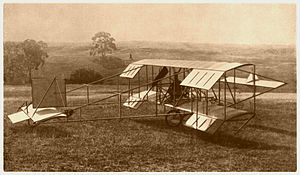
Eugene Burton Ely was an American aviation pioneer, credited with the first shipboard aircraft takeoff and landing.
The 1911 Curtiss Model D was an early United States pusher aircraft with the engine and propeller behind the pilot's seat. It was among the first aircraft in the world to be built in any quantity, during an era of trial-and-error development and equally important parallel technical development in internal combustion engine technologies.

The Boxkite was the first aircraft produced by the British and Colonial Aeroplane Company. A pusher biplane based on the successful Farman III, it was one of the first aircraft types to be built in quantity. As the type was used by Bristol for instruction purposes at their flying schools at Larkhill and Brooklands many early British aviators learned to fly in a Boxkite. Four were purchased in 1911 by the War Office and examples were sold to Russia and Australia. It continued to be used for training purposes until after the outbreak of the First World War.

Charles Francis Walsh was an American pioneer aviator who died in a crash in Trenton, New Jersey.

The Blériot XI is a French aircraft from the pioneer era of aviation. The first example was used by Louis Blériot to make the first flight across the English Channel in a heavier-than-air aircraft, on 25 July 1909. This is one of the most famous accomplishments of the pioneer era of aviation, and not only won Blériot a lasting place in history but also assured the future of his aircraft manufacturing business. The event caused a major reappraisal of the importance of aviation; the English newspaper The Daily Express led its story of the flight with the headline "Britain is no longer an Island".

The Antoinette IV was an early French monoplane.

The Maurice Farman MF.7 Longhorn is a French biplane developed before World War I which was used for reconnaissance by both the French and British air services in the early stages of the war before being relegated to service as a trainer.

The Avro Type E, Type 500, and Type 502 made up a family of early British military aircraft, regarded by Alliott Verdon Roe as his firm's first truly successful design. It was a forerunner of the Avro 504, one of the outstanding aircraft of the First World War.

The 1907 Voisin biplane, was Europe's first successful powered aircraft, designed by aeronautical engineer and manufacturer Gabriel Voisin. It was used by the French aviator Henri Farman to make the first heavier-than-air flight lasting more than a minute in Europe, and also to make the first full circle. The first examples of the aircraft were known by the name of their owners, for instance the Delagrange I, or the Henri Farman n°1. Farman made many modifications to his aircraft, and these were incorporated into later production aircraft built by Voisin. The type enjoyed widespread success, and around sixty were built.

The Farman III, also known as the Henry Farman 1909 biplane, was an early French aircraft designed and built by Henry Farman in 1909. Its design was widely imitated, so much so that aircraft of similar layout were generally referred to as being of the "Farman" type.
De Havilland Biplane No. 1 is a name applied retrospectively to the first aircraft constructed by Geoffrey de Havilland, who built and flew it once in December 1909. De Havilland undertook the project with the assistance of his friend, and soon to be brother-in-law, Frank Hearle, and financed the project with £1,000 borrowed from his maternal grandfather as an advance on his inheritance.

John Robertson Duigan MC was an Australian pioneer aviator who built and flew the first Australian-made aircraft.

The Wright Model R was a single-seat biplane built by the Wright Company in Dayton, Ohio, United States, in 1910. Also known as the Roadster or the Baby Wright, it was designed for speed and altitude competitions.

The Short S.27 and its derivative, the Short Improved S.27, were a series of early British aircraft built by Short Brothers. They were used by the Admiralty and Naval Wing of the Royal Flying Corps for training the Royal Navy's first pilots as well as for early naval aviation experiments. An Improved S.27 was used by C.R. Samson to make the first successful take-off from a moving ship on 9 May 1912.
The Paterson Biplane was an early British biplane designed by Cecil Compton Paterson and built at the Liverpool Motor House, where Paterson was a director. It was later called the Paterson No. 1 Biplane to distinguish it from subsequent aircraft designed by Paterson.

The Paulhan biplane was a French experimental aircraft designed in 1910 by the successful aviator Louis Paulhan in collaboration with Henri Fabre. The prototype became the second aircraft bought by the British War Office: two further examples, differing in constructional detail, were built.
The Voisin Type Bordeaux was an aircraft built by Voisin Frères in 1910, so named because it was used by Juan Bielovucic to make a record-breaking flight from Paris to Bordeaux in France. The design differed significantly from previous Voisin designs in eliminating the forward-mounted elevator.
The Aeronautical Syndicate Limited (ASL) was one of the earliest aeroplane manufacturers. A British company, it was founded in 1909 by the investor Horatio Barber and engineers William Oke Manning and Howard T. Wright. Initially located in Battersea, London, the business soon relocated to Larkhill on Salisbury Plain. It later moved to the Aeronautical Syndicate Flying School, Hendon. The company closed in 1912.

Basil George Watson was an Australian aviation pioneer who died in an aeroplane crash while testing his self-constructed plane on the day before a Red Cross fund-raising carnival at which he was scheduled to give a display of aerobatics.

















